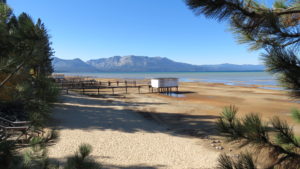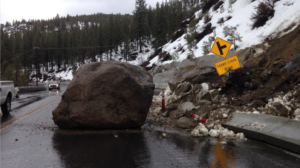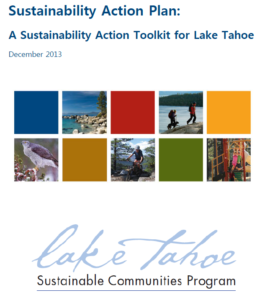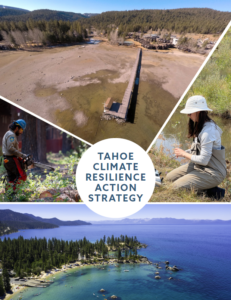Climate Resilience
TRPA and its partners in the bi-state Lake Tahoe Region have long been recognized as leaders in sustainability. A significant new environmental threat, one that many believe will affect sustainability of the entire planet, has emerged: climate change. The Lake Tahoe Basin is already experiencing the direct impacts of climate change.
An alpine ecosystem as fragile as Tahoe’s can suffer even from small changes. The impacts of warming air and water temperatures could be devastating: More severe droughts and storms. Changing weather with more rain and less snowfall. Tree mortality, longer wildfire seasons, and more intense fires. Warming lake waters increasingly susceptible to algae growth, invasive species, and reduced water clarity. Extreme weather impacts on the transportation network and visitation patterns.
California and Nevada have aggressive targets to reduce greenhouse gas emissions and build both climate adaptation and resilience. Working together to implement the national award-winning 2014 Lake Tahoe Sustainability Plan, regional partners will reduce greenhouse gas emissions and strengthen the region’s resiliency.
As a major drive-up destination for millions of Northern California and Northern Nevada residents, TRPA and dozens of partners, including inter-regional partners in neighboring metropolitan areas, must implement major improvements for the transportation system, which is the largest contributor of greenhouse gases in both states. TRPA’s Climate Initiative is harmonizing the goals of both states and local governments in the Tahoe Basin while maintaining the Region’s reputation as a global leader in sustainability.
Lake Tahoe Climate Resilience Action Strategy
Lake Tahoe Climate Resilience Action Strategy builds on existing Tahoe Basin climate and environmental improvement plans to identify five focus areas that will advance equity, create jobs, and build resilience for the Basin’s extraordinary natural resources, 57,000 residents, and an economy that supports 15 million annual visitors.
Wildfire, landslides, avalanches, and floods threaten the safety of Tahoe’s residents and visitors. A 2020 study, completed by the California Tahoe Conservancy, identified the impact of climate change at Tahoe. Annual road damages are increasing and could exceed $75 million by 2100. Winter recreation seasons are already shorter and will be cut in half by 2100, causing the ski industry $268 million in annual losses. Loss of lake clarity due to warming water temperatures will impact the region’s $5 billion tourism-based economy. Wildfire threatens $26.9 billion in property value. Meadow degradation threatens sites that are important to the Washoe Tribe of Nevada and California.
Now is the time to confront the climate crisis. Addressing the impacts of climate change up front is more cost-effective than waiting for catastrophe. It would cost three times less to protect infrastructure from floods than to pay for damages from a major flood. Each $1 million invested in climate adaptation projects will reduce property damage by $10 million.
We must act now to preserve and protect Lake Tahoe for this and future generations.
Explore Climate Resilience Projects
Climate Impacts at Tahoe
The Tahoe Basin Vulnerability Assessment, completed by the California Tahoe Conservancy, includes down scaled science from the California’s 4th Climate Assessment to analyze specific climate change impacts to the Tahoe Basin. The assessment identified the following climate impacts to the Tahoe Region.
Temperature & Precipitation
- Hotter summers: by 2100 summer in Tahoe will feel almost as hot as summer in Reno does today.
- Extreme storms and flooding: the amount of rainfall from the largest storms
Lake Tahoe
- Lake clarity: warmer temperature and decreased deep-water mixing will diminish clarity. Larger and more frequent wildfire and floods will increase sediment flows into the lake.
- Lake level: the lake level will be above and below the natural rim more often in will increase by up to 30 percent, causing more flooding to communities. It would cost three times less to adapt to flooding than to pay for damages.

Low Lake Level, 2015
- Snowpack: rising temperatures will cause more precipitation to fall as rain rather than snow at lake level. The future. Tahoe city dam will overtop one or two times each decade.
- Stream runoff: runoff will peak five months earlier, and affect ecosystems and downstream water resources.
- Invasive species: warmer temperatures will make nearshore water more hospitable for aquatic invasive species.
Forested Uplands
- Wildfires: wildfires will be larger and more frequent. By 2100 the total area burned each decade is projected to be 61 percent larger than in 2000. Wildfire threatens people and $26.9 billion in total property value. Each $1 million invested in adaptation would reduce property damages by $10 million.
- Droughts and forest health: longer, more frequent droughts and increased insect outbreaks will kill more trees, further increasing wildfire risk.
- Native species: reduced habitat will cause some native species to decline or even become locally extinct.
- Meadows: many meadows will dry out for longer periods, and eventually convert to forest or shrubs.
Communities & Infrastructure
- Winter recreation: by 2100 the length of the winter recreation season will decrease by half. The 12 ski resorts in the Tahoe region could lose $268 million annually.
- Summer recreation: the length of the summer recreation season will increase. Lower lake levels caused by extended droughts will impact boating, beaches, and water sports.

Logan Shoals Rock Slide
- Cultural landscapes: large high-severity wildfires will destroy culturally important resources, artifacts, and sites.
- Smoke events: wildfires will cause more smoky days. By 2050 the health-related costs from a single wildfire could be $7 million to $40 million.
- Roads: the risk that landslides, wildfire, flooding, and avalanches damage highways will increase. Annual road damages could exceed $75 million by 2100.
- Infrastructure: extreme weather, wildfire, and other hazards could create more frequent outages for water, energy, and communication infrastructure. Higher lake levels may flood lakefront properties.
The Tahoe Climate Adaptation Action Primer provides a summary of the impacts listed above.
Greenhouse Gas Emission Inventories
Greenhouse gas emissions trap heat in the atmosphere, causing the climate to warm. According to research by UC Davis Tahoe Environmental Research Center, global climate change has increased the lake’s average water temperature more than 1 degree Fahrenheit over the last century. Warmer lake temperatures encourage the growth of clarity-harming algae and improve habitat for aquatic invasive species that threaten the entire ecosystem.
The TRPA, in continuing progress toward addressing the threats of climate change, regularly measures the region’s greenhouse gas (GHG) emissions.
Greenhouse Gas Inventory (2015 and 2018)
The inventory shows that overall, progress is being made toward GHG emission reduction goals. From 2005 to 2018, the Tahoe Region’s emissions have declined significantly by 38.7 percent. Total emissions were reduced from 1,297,446 metric tons of carbon dioxide equivalent to 795,793 metric tons. Metric tons of carbon dioxide equivalent (mtCO2e) is a common measure to compare various greenhouse gasses in terms of their equivalent warming potential to carbon dioxide.
On average between the years of 2015 and 2018, the energy sector produced more than half the emissions in the basin (59 percent), followed by transportation (37 percent). In combination, these two sectors generate more than 95 percent of total emissions in the basin and therefore have the most potential for reduction.
For the first time, the updated inventory modeled carbon sequestration potential in Tahoe’s forests and meadows and compared those to annual emissions. The updated inventory found that the natural landscape sequestered or stored between 300,000 and 1,000,000 mtCO2e in 2018. This is compared to about 800,000 mtCO2e in emissions for 2018. Carbon sequestration by forests and meadows is a natural climate solution, and the Tahoe region is fortunate to have an abundance of undeveloped landscapes that contribute to this cycle.
Final Greenhouse Gas Inventory Report
Infographic
Final Presentation
GHG Webinar Materials
March 5, 2021 webinar recording
Meeting slides
Questions and Answers
Previous Inventories
Tahoe Basin Greenhouse Gas Emissions Inventory (2005 and 2010)
Other Inventories
Climate Adaptation
Climate adaptation is needed to create a built and natural environment that can respond to climate change impacts that cannot be avoided, like wildfires and flooding. Adapting to the impacts of climate change is necessary to safeguard the quality of life, land, and waters at Tahoe. The states of California and Nevada, Tahoe Regional Planning Agency (TRPA), Tahoe Transportation District (TTD), Washoe Tribe of Nevada and California (Washoe Tribe), and federal, local, and private partners are proactively adapting to climate change and making our communities, infrastructure, and natural resources more resilient.
Both research and action planning to increase the adaptive capacity is summarized below. Advancing climate adaptation will build the region’s resilience to climate change impacts.
Climate Vulnerability
Developing climate adaptation actions starts with understanding the vulnerabilities to climate change a region, infrastructure, and community faces today and in the future.
- Climate Change Vulnerability and Adaptation for Infrastructure and Recreation in the Sierra Nevada (2021). USDA Forest Service Pacific Southwest Research Station.
- Tahoe Basin Vulnerability Assessment (2020). Completed by the California Tahoe Conservancy, includes down scaled science from the 4th Assessment to analyze specific climate change impacts to the Tahoe Basin.
- Placer County Vulnerability Assessment (2018). Identifies climate impacts specific to Placer County, including the Tahoe Basin portion of the county.
Adaptation Plans
To adapt to known climate impacts, regional partners have created several implementation plans that will build the Region’s adaptive capacity and climate resilience.
- Lake Tahoe Climate Resilience Action Strategy builds on existing Tahoe Basin climate and environmental improvement plans to identify five focus areas that will advance equity, create jobs, and build resilience for the Basin’s extraordinary natural resources, 57,000 residents, and an economy that supports 15 million annual visitors. We must act now to preserve and protect Lake Tahoe for this and future generations.
- Sustainability Action Plan (2014). Chapter 5: Climate Change Readiness identifies 35 regional adaptation actions.
- Tahoe Climate Adaptation Action Primer (2021) and Climate Adaptation Action Portfolio (2021). Highlights adaptation actions currently taking place in the Tahoe Basin in response to the Basin-wide vulnerability assessment.
- Placer County Sustainability Plan (2020). A comprehensive plan that outlines various programs and policies that will be undertaken to meet California’s greenhouse gas emission reduction goals and reduce the county’s vulnerability to climate.
- Safeguarding California (2018). Statewide climate adaptation plan. 2021 Adaptation Strategy Update (ongoing).
Climate Plans
Lake Tahoe Climate Resilience Action Strategy builds on existing Tahoe Basin climate and environmental improvement plans to identify five focus areas that will advance equity, create jobs, and build resilience for the Basin’s extraordinary natural resources, 57,000 residents, and an economy that supports 15 million annual visitors. We must act now to preserve and protect Lake Tahoe for this and future generations.
In 2013, a greenhouse gas inventory and future projections were completed for the Tahoe Region. This inventory found that generation of electricity, transportation, and fuel combustion for heating and cooking are the top three emissions sources in the Region and constitute 90% of all emissions. The completion of this inventory led to the creation of the Lake Tahoe Sustainable Communities Program, a multi-sector collaborative funded by the Strategic Growth Council, and the national award-winning Sustainability Action Plan in 2014.
The Action Plan outlined a comprehensive regional approach to reducing greenhouse gas emissions and adapting to climate change (mitigation and adaptation). The Action Plan received Sacramento Section, California Chapter and National awards from the American Planning Association in 2014 and 2015. To date, basin partners have implemented nearly 76% of actions identified in the Action Plan. Other components of the Sustainability Program included an Economic Development Strategy and supported implementation of the Regional Plan through creation of the initial version of the Area Plan Framework.
2014 Sustainability Action Plan
- Sustainability Vision and Framework
- Action Plan Background
- Final Sustainability Action Plan
- Lake Tahoe Sustainability Indicators Reporting Plan
- Area Plans Framework
- Area Plans Background
- Development Commodities Transfer Policies Analysis
- Development Commodities Tracking and Exchange System
- Economic Development Strategy
- LTSC Strategic Plan
- Annual Sustainability Report
- Lake Tahoe Sustainable Communities Program Summary
Appendix A: Greenhouse Gas Inventory
The work upon which the publication is based was funded in whole or in part through a grant awarded by the California Strategic Growth Council.
Climate Planning Since 2014
In addition to the successful implementation of many of the components of the Lake Tahoe Sustainability Program, other notable inputs and changes in relevant climate change policy and information since 2014 include:
- Water for the Seasons (ongoing). Study by Desert Research Institute to understand impacts of climate change on water operations in the Truckee River Basin.
- Tahoe-Truckee Plug-in Electric Vehicle Readiness Plan (2017). Plan for deployment and incentivization of electric vehicles and charging infrastructure.
- Placer County Sustainability Plan (2020). A comprehensive plan that outlines various programs and policies that will be undertaken to meet California’s greenhouse gas emission reduction goals and reduce the county’s vulnerability to climate.
- City of South Lake Tahoe Climate Action Plan (2021). The City Climate Action Plan to identify projects to achieve their 100% Renewable Pledge and statewide climate mandates.
- Tahoe Climate Adaptation Action Primer (2021) and Climate Adaptation Action Portfolio (2021). Highlights adaptation actions currently taking place in the Tahoe Basin in response to the Basin-wide vulnerability assessment.
- Safeguarding California (2018). Statewide climate adaptation plan. 2021 Adaptation Strategy Update (ongoing).
- Nevada’s State Climate Strategy (2020). Nevada’s first climate strategy, an integrated, economy-wide roadmap for the Silver State to accelerate climate action necessary to achieve Nevada’s climate goals and capture the health and economic benefits of the clean energy and technology revolution.
Many communities have emerged as climate leaders with outstanding climate plans, including Los Angeles, San Diego, and Aspen paving a path forward for other communities to take bolder climate action.
Zero Emission Vehicle Program
Plug-in electric vehicles and other zero-emission vehicles could transform the Tahoe-Truckee Region by dramatically reducing petroleum consumption, greenhouse gas emissions, and noise; improving water quality/clarity; and increasing energy independence and transportation choices. In 2017, TRPA partnered with the Truckee-Donner Public Utility District to create the Tahoe-Truckee Plug-in Electric Vehicle Readiness Plan. The plan’s goal is to support adoption of zero emission vehicles through improved infrastructure, funding, and education. The plan was awarded Best Overall Plan and Best Overall Outreach in 2018 by the Nevada Chapter of the American Planning Association. Click here to learn more about the program.
Additional Resources
Climate Smart Code
TRPA is embarking on a process to update our code of ordinances to promote more climate smart development and incentivize resilience.
October 2022 – TRPA staff presented initial code update ideas to the Governing Board for input. Identified priorities will advance to stakeholder input and adoption in 2023.
Climate Mandates
A variety of mandates to address climate mitigation, adpatation, and resiliency exist at a global, federal, state, regional, and local level. TRPA works with partners across each of these scales to ensure Tahoe is meeting thier intended goals. An incomplete list of relevant climate mandates for the Tahoe Region is listed below.
United Nations
- Paris Agreement. The Agreement includes commitments from all countries to reduce their emissions and work together to adapt to the impacts of climate change, and calls on countries to strengthen their commitments over time.
Federal
- EO 14008: Tackling the Climate Crisis at Home and Abroad. Broad action toward climate, including 30 by 30 conservation goal.
- EO 14057: Catalyzing Clean Energy Industries and Jobs Through Federal Sustainability. Establishes targets for 100% renewable engery, electric vehilce adoptions, greenhouse gas reduction, and climate resilient infrastructure.
- Conserving and Restoring America the Beautiful.
TRPA Bi-State Compact
- Article 1.a.5 – Increasing urbanization is threatening the ecological values of the region and threatening the public opportunities for use of the public lands
- Climate change is a result of carbon emissions from industrialization and increased urbanization built on fossil fuels. These urban emissions threaten all aspects of Tahoe’s environment and the ability for people to access Tahoe.
- Threshold Standards. Climate Change is already impacting TRPAs ability to achieve and maintain threshold standards.
- A land-use Regional Plan, Regional Transportation Plan, Conservation Plan, and Public Services and Facilities Plan are all required by the compact. These goals of these plans are impacted by climate change, and the implementation of climate action can take place through their regional mechanism.
- Sustainability Action Plan: A 15 percent reduction from the Lake Tahoe Region baseline (average of the 2005 and 2010 GHG emissions inventories) by 2020, a 49 percent reduction by 2035, and net-zero carbon emissions by 2045.
California
- SB 32 Greenhouse Gas emission reduction target for 2030. Establishes a statewide greenhouse gas (GHG) emission reduction target of 40 percent below 1990 levels by 2030. (Pavley 2016)
- SB 375 The Sustainable Communities and Climate Protection Act of 2008. Set transportation related emission reduction targets. Tahoe is responsible for an 8% reduction by 2020 and an additional 5% by 2035.
- Executive Order B-55-18. Established a new statewide goal to achieve carbon neutrality as soon as possible, and no later than 2045, and achieve and maintain net negative emissions thereafter. (Brown 2018)
- Executive Order B-16-12. orders State agencies to facilitate the rapid commercialization of zero-emission vehicles (ZEVs). The Executive Order sets a target for the number of 1.5 million ZEVs in California by 2025.
- Executive Order B-48-18. directs state government to meet a series of milestones toward a long-term target of 1.5 million ZEVs on California’s roadways by 2025 and 5 million by 2030. (Brown 2018)
- SB 100 California Renewables Portfolio Standard Program. Established a goal of that renewable energy resources and zero-carbon resources supply 100% of retail sales of electricity to California end-use customers and 100% of electricity procured to serve all state agencies by December 31, 2045. The bill also established interim targets of 50% renewable resources by December 31, 2026, and a 60% target by December 31, 2030 (De León 2018).
- AB 1482 Safeguarding California. Prioritizes climate adaptation across state agencies to safeguard California and requires a statewide adaptation plan that is updated every three years (Gordon 2015).
- Executive Order N-19-19. Require that every aspect of state government redouble its efforts to reduce greenhouse gas emissions and mitigate the impacts of climate change while building a sustainable, inclusive economy (Newsom 2019).
- Executive Order N-79-20. Establishes a goal of the State that 100 percent of in-state sales of new passenger cars and trucks will be zero-emission by 2035. It shall be a further goal of the State that 100 percent of medium- and heavy-duty vehicles in the State be zero-emission by 2045, among other emission reduction goals (Newsom 2020).
- Full list of California climate change legislation, regulations, and executive orders: https://www.law.berkeley.edu/research/clee/research/climate/climate-policy-dashboard/
Nevada
- SB 254 Relating to Greenhouse Gas Emissions. Establishes goal on net-zero carbon emissions by 2050 (Brooks, et. al. 2019).
- SB 358 Revised Renewable Portfolio Standard. Establishes a carbon free electricity generation goal by 2050 (Brooks, et. al. 2019).
- Executive Order 2019-22. Set greenhouse gas emissions reduction target of 28 percent below 2005 levels by 2025 and 45 percent below 2005 levels by 2030. (Sisolak 2019)
Local
- City of South Lake Tahoe Resolution 2012-. 100 Percent Renewable, Carbon-Free Electricity, 24/7 by 2030.
- City of South Lake Tahoe Resolution 2017-26. 80 percent reduction in total greenhouse gas emissions by 2040.
Climate Science
Global
- United Nations Fifth Climate Change Assessment (2013)
- United Nations Sixth Climate Change Assessment (2022)
National
- US Environmental Protection Agency. Federal climate change science and research.
State
- Cal-Adapt 2.0. Data clearinghouse and interactive tools for California.
- California statewide greenhouse gas emissions inventory (2021). Data and trends for statewide emissions from 2000 to 2019.
- California’s Fourth Climate Change Assessment (2018) Included down scaled analysis of impacts of climate change on regions of California, including the Sierra Nevada.
- Sierra Nevada Regional Assessment (2018)
- Climate Change Research Plan for California (2015). Presents priorities for the next 3-5 years (from late 2014-2020) California-specific climate change research and most critical climate-related research gaps.
- Nevada Climate Database. Database for Nevada climate research.
- Nevada GHG inventory Reports. Inventory and projections of statewide emissions from 1990 to 2039.
Regional
- Truckee Basin Study, Bureau of Reclamation (2015). Report analyzing impacts of climate change on water supply for the Truckee River Basin.
- Climate Change Vulnerability and Adaptation for Infrastructure and Recreation in the Sierra Nevada (2021). USDA Forest Service Pacific Southwest Research Station.
- Tahoe Basin Vulnerability Assessment (2020). Completed by the California Tahoe Conservancy, down scaled science from the 4th Assessment to analyze specific climate change impacts to the Tahoe Basin.
- Placer County Vulnerability Assessment (2018). Identifies climate impacts specific to Placer County, including the Tahoe Basin portion of the county.
- UC Davis Tahoe Environmental Research Center
- Water for the Seasons (ongoing). Study by Desert Research Institute to understand impacts of climate change on water operations in the Truckee River Basin.


